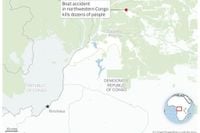Tragedy struck northwestern Congo this week as two devastating boat accidents claimed the lives of at least 193 people, leaving scores more missing and communities reeling from the aftermath. The incidents, which unfolded just a day apart in the Equateur Province, have brought renewed scrutiny to the safety of river travel in the region and exposed the vulnerabilities faced by those who rely on the Congo River as their primary means of transportation.
According to multiple reports from state media and international news agencies such as The Associated Press, the first of the two disasters occurred on Wednesday, September 10, 2025, in Basankusu territory. A motorized boat, heavily loaded with passengers—most of them students—capsized, resulting in at least 86 confirmed deaths. The true number of victims may be even higher, as several people remain unaccounted for. Images from the scene showed villagers gathered in mourning around the bodies of their loved ones, a stark reminder of the profound human cost of the tragedy.
State media attributed the Basankusu accident to "improper loading and night navigation," citing eyewitness accounts and reports from the scene. The overloaded vessel, lacking sufficient safety equipment such as life jackets, was reportedly traveling at night—a practice that, while common, significantly increases the risks of such journeys. The combination of poor visibility and excessive weight proved deadly, and the lack of immediate rescue resources only compounded the disaster.
Just over 150 kilometers away, a second catastrophe unfolded the following evening. On Thursday, September 11, a whaleboat carrying nearly 500 passengers caught fire and capsized near the village of Malange in Lukolela territory, also along the Congo River. Congo’s humanitarian affairs ministry reported that 209 survivors were rescued from the wreckage, but the death toll from this single incident, when combined with the previous day’s tragedy, pushed the total number of confirmed fatalities to at least 193. Many more are feared missing, their fates unknown as rescue operations struggled to keep pace with the scale of the disaster.
The scale and proximity of these accidents have sent shockwaves through the region, prompting grief, anger, and urgent calls for action. Local civil society groups have pointed fingers at government authorities, blaming lax enforcement of safety regulations and inadequate oversight for the mounting toll. One such group, speaking to The Associated Press, claimed that the actual number of casualties in the Basankusu accident could be even higher than officially reported, though authorities have not confirmed this.
For many in Congo, the tragedies highlight a grim reality: river travel, while essential, is fraught with peril. As roads in the region remain few and far between, the Congo River serves as a lifeline for commerce, education, and daily life. Yet the vessels that ply its waters are often wooden, aging, and poorly maintained, routinely crammed well beyond their intended capacity. The scarcity of life jackets and other safety gear only heightens the danger, especially when boats journey at night—a practice driven by economic necessity but fraught with risk.
“The capsizing of boats is becoming increasingly frequent in this central African nation as more people are abandoning the few available roads for cheaper, wooden vessels crumbling under the weight of passengers and their goods,” reported The Associated Press. This trend, exacerbated by poverty and limited infrastructure, has made such tragedies all too common. In the words of one local observer, “Life jackets are rare and the vessels are usually overloaded. Many of the boats also travel at night, complicating rescue efforts during accidents and leaving many bodies often unaccounted for.”
State media and humanitarian officials have yet to provide a comprehensive account of how many people remain missing in the wake of the two disasters. Rescue operations, hampered by darkness, limited equipment, and the sheer size of the river, struggled to reach survivors in time. As of Friday evening, it remained unclear whether efforts were ongoing or had shifted to recovery and identification of the deceased.
The impact on local communities has been profound, with many families mourning multiple losses. The fact that so many of the victims were students has only deepened the sense of tragedy, as dreams of education and a better future were cut short in an instant. In Basankusu and Lukolela territories, scenes of grief have played out in public squares and along the riverbanks, with villagers gathering to honor the dead and search for the missing.
The government response has so far been muted, with authorities difficult to reach for comment and no immediate announcements of policy changes or new safety measures. This silence has fueled frustration among local residents and advocacy groups, who argue that more must be done to prevent similar disasters in the future. The recurring nature of such accidents suggests systemic problems: poor enforcement of safety standards, inadequate vessel maintenance, and a lack of investment in transportation infrastructure.
Observers note that the risks associated with river travel are not new, but recent years have seen an uptick in frequency and severity. As economic pressures mount and road networks remain underdeveloped, more Congolese are turning to riverboats as their primary means of getting from place to place. The result is a vicious cycle: increased demand leads to more crowded boats, which in turn raises the likelihood of capsizing or other accidents.
International organizations and regional governments have periodically called for reforms, urging Congo to invest in safer vessels, enforce passenger limits, and provide basic safety equipment like life jackets. Yet progress has been slow, hampered by limited resources and competing priorities. For the families affected by this week’s tragedies, such calls offer little comfort in the face of immediate loss.
As the nation mourns, questions remain about what, if anything, will change. Will the deaths of nearly 200 people in just two days spur action, or will the cycle of tragedy continue unchecked? The answer, for now, is uncertain. What is clear is that the dangers of river travel in Congo are both acute and chronic, and without significant intervention, more lives will almost certainly be lost.
For the people of Equateur Province, the events of this week are a stark reminder of the urgent need for reform. Whether those in power will heed the warning remains to be seen, but the cost of inaction is measured not just in statistics, but in the shattered lives of families up and down the Congo River.



